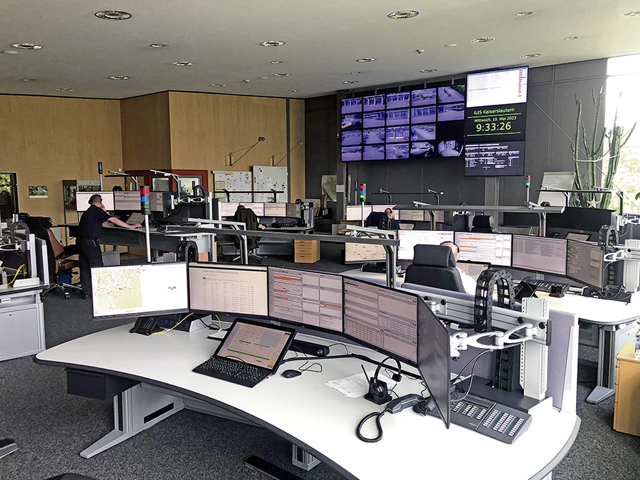
Most U.S. military personnel are familiar with the individual command posts on Air Force and Army installations within the Kaiserslautern Military Community. But, did you also know that there is a significant German control center of similar nature located in Kaiserslautern?
The Integrierte Leitstelle Kaiserslautern (operation control center) is situated along B37 enroute to downtown Kaiserslautern. It was established in 2006 prior to the Soccer World Cup and is the second of its kind in Rheinland-Pfalz. The first was in Trier and in the meantime, there are six others in the state. The center is responsible for the fire department, rescue services, disaster response, medical transportation and dispatch for large parts of the Westpfalz region.
The center services 112-emergency calls from the three counties of Kaiserslautern, Kusel and Donnersberg and the City of Kaiserslautern. This encompasses an area of approximately 2,000 square kilometers and a total of 425,000 inhabitants, including about 50,000 members of the KMC. In addition, the center is responsible for 19222 calls intended for medical transport.
The ILts alarms, leads and supports an average of 433 operations daily, totaling 158,000 in-coming calls per year. The 60-member staff is made up of full-time, part-time and two voluntary employees that work on a rotating basis and man the center 24 hours a day. This includes personnel from the German Red Cross, Arbeiter-Samariter-Bund, Malteser Hilfsdienst and Kaiserslautern’s fire department’s fire fighters and first responders.
The center currently coordinates 226 fire stations and 120 first responder units with 473 vehicles, 22 emergency medical service stations and 32 disaster management and civil defense units. In addition, there is a direct communication line with Fire Station One on Ramstein Air Base and the fire department at Rhine Ordnance Barracks.
There are very stringent requirements, and to work in the position as a dispatcher, the person needs full qualification as a fire fighter squad leader.
The operation control center contains 10 dispatcher workstations, five disaster management workstations and one mobile operation control center for mission control, which can be used on site during large events.
The center has 24 lines for direct 112-calls and 8 lines for 19222 calls. In the case of an immediate medical emergency, a dispatcher will notify the vehicle closest to the incident to ensure the shortest response time possible based on a geo referenced principle. For example, a caller from Winnweiler (in Donnersberg County) would be picked up from an ambulance at the station in Winnweiler, while someone from Landstuhl would be transported with a vehicle at the closest proximity at that time.
In addition, the center is responsible for 325 automatic fire alarm systems, for example for companies or stores, and 1450 personal medical alarms. As a statistic, the center serviced 108,729 medical calls, the fire and rescue department responded to 1,326 fire alarms, 1,866 rescues, two storms, 193 security guard incidents and 675 other operations last year.
After the Flugtag Disaster in 1988, it became clear that closer coordination was necessary, and a Mutual Assistance Agreement and Alarm and Response Plan were developed.
The MAA was signed in 1990 in an effort to enhance communication to save lives throughout the KMC in case of emergencies. The agreement includes assistance with fire protection, general aid and disaster preparedness and serves both U.S. citizens and the local German populace.
Depending on the type of contingency, the ARP clearly lays out the responsibilities of host nation key players and provides need-to-know information flow to German leaders at local and state level and establishes the connection between U.S. leadership and local decision makers. Key military leaders recently visited the center to familiarize themselves with its modus operandi.
The ILts also aims to keep close ties with Air Force and Army response agencies within the KMC and joint tabletop and hands-on exercises take place on a regular basis. A joint exercise with Kaiserslautern County is planned in the near future, with KMC key players and local agencies expected to participate to sharpen their skills and be well prepared.
The Operation Control Center is instrumental in informing and warning the population and safeguards the lives of KMC members and Germans alike, twenty-four hours a day, 365 days a year.


